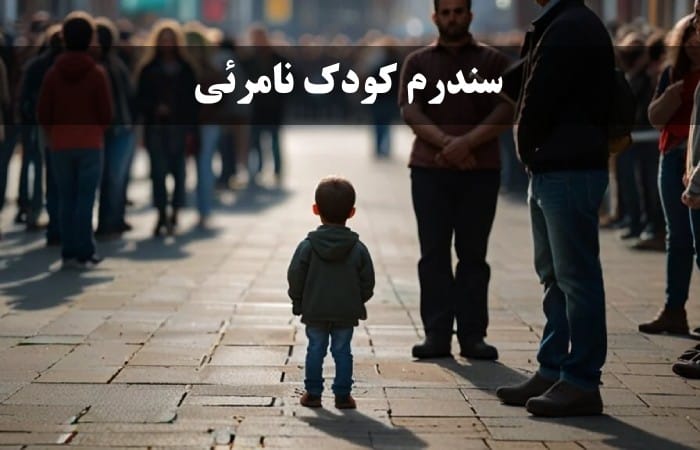
Blog
Invisible child syndrome

Invisible Child Syndrome refers to a condition in which a child is deprived of emotional support, the development of individual identity, and meaningful participation in social interactions due to systematic neglect by family systems or social institutions. Although this phenomenon is not classified as an independent disorder in common psychiatric diagnostic manuals (such as the DSM-5), it has been examined in research literature related to emotional child abuse, emotional neglect, and dysfunctional family communication patterns as one of the chronic psychological consequences.
فهرست عناوین
ToggleThe concept was first introduced in the 1980s by psychologists such as Dr. Judith Viorst in longitudinal studies of large families. Her findings showed that children who occupy the “middle child” position often internalize feelings of invisibility and exclusion gradually, due to the unequal distribution of parental attention and the prioritization of other siblings’ needs. Today, the scope of this syndrome has extended beyond the family framework to include institutions such as educational systems and social welfare programs, whose inability to identify and respond to the needs of unsupported children perpetuates this cycle.
Definition of Invisible Child Syndrome (ICS)
Invisible Child Syndrome (ICS) refers to a psycho-social phenomenon in which a child, due to systematic neglect within the family or community environment, is deprived of fundamental emotional needs and the formation of an independent identity. This phenomenon often occurs in families where parental attention is unfairly distributed among siblings.
For example, in a family of four, Sara (8 years old) grows up in a situation where her parents’ attention is drawn to two opposing poles: her older sister, who is the “academic star” and has earned all the family’s honors, and her younger brother, who requires constant medical care due to Type 1 diabetes. Meanwhile, Sara unintentionally falls into the emotional margin of the family. Her emotional needs—such as the need to play, to have her opinions heard, or to receive encouragement—are consistently overlooked.
This neglect pushes Sara into the role of the “invisible listener.” In family conversations, she is merely an observer; no one asks for her opinion, and her physical presence rarely influences decision-making. To break this cycle, Sara resorts to nonverbal means: before bedtime, she mimics exaggerated coughing to draw her parents to her room. However, her parents interpret this behavior not as a sign of emotional loneliness but as “childish jealousy,” and by saying things like, “Are you playing a role again?” they unintentionally deepen her emotional exclusion.
This example clearly demonstrates how the three key features of Invisible Child Syndrome intertwine in a real-life context:
- Continuous neglect of psychological needs: The child grows up in an environment where their emotions, fears, or interests are repeatedly ignored.
- Functioning as a “passive listener”: The child’s role in family or social interactions is reduced to a one-sided position, where they only receive others’ demands without the right to express themselves.
- Tendency toward maladaptive compensatory mechanisms: To break the cycle of invisibility, the child resorts to behaviors such as factitious disorder imposed on self (simulating illness), proactive aggression, or extreme social withdrawal.
The consequence of this cycle is the internalization of the belief, “I am not worthy of attention,” and diminished self-esteem, which can persist into adulthood as anxiety disorders or avoidance of social relationships.

Causes of Invisible Child Syndrome
Invisible Child Syndrome has its roots in a complex interplay of individual, familial, and social factors. This phenomenon is not caused by a single factor but is the product of overlapping cycles of intergenerational neglect, dysfunctional family structures, and cultural pressures. Below, the key mechanisms behind the formation of this syndrome are examined:
Damaged Parenting Patterns and Intergenerational Transmission
Parents who themselves were victims of emotional neglect during childhood often lack the necessary skills to recognize and respond to the emotional needs of their own children. According to John Bowlby’s attachment theory, such parents, by creating insecure attachment patterns (such as avoidant or ambivalent attachment), inadvertently perpetuate the cycle of neglect.
For example, a 2021 study by the National Institute of Mental Health (NIMH) on 300 families found that 40% of parents with narcissistic personality disorder designate one child as the “symbol of success,” while marginalizing the others due to an excessive focus on that favored child. This behavior not only ignores the needs of the marginalized children but also instills a sense of “conditional love,” thereby embedding destructive behavioral patterns in the next generation.
Heterogeneous Family Structures and Unequal Distribution of Resources
In families with complex configurations (single-parent households, adoption, or presence of chronic illnesses), limited emotional and financial resources often lead to the systematic neglect of certain children. For example, in a real case, a mother of a family with four members and two children with autism admitted in an interview: “All my energy is spent managing daily crises. Even when my healthy son steps forward to help me, I forget he exists.” This instability in the distribution of attention pushes children who seem “less problematic” toward passive roles.
Cultural Norms and the Reproduction of Discriminatory Stereotypes
In some societies, structural biases based on gender, birth order, or physical traits lead to the systematic exclusion of specific groups of children.
This analysis indicates that combating Invisible Child Syndrome requires simultaneous interventions at individual levels (parenting skills training), family levels (specialized counseling), and social levels (reforming discriminatory laws).

Three Signs of Invisible Child Syndrome and Concrete Examples
Invisible Child Syndrome manifests through a set of multidimensional signs that appear in emotional, behavioral, and social domains. These signs often emerge silently and progressively and, if left untreated, can lead to persistent psychological disorders.
Emotional-Psychological Signs
- Structural feelings of worthlessness: The child believes their existence is considered a “burden” to the family or society.
For example, a 9-year-old child in a counseling session explains: “When we go outside, my mother only holds my sister’s hand. I always think if I get lost, no one will find me.” - Excessive existential questions: Questions like “If I didn’t exist, would everyone else’s life be better?” or “Does anyone hear my voice?”
- Separation anxiety: A pathological fear of rejection that does not diminish even in the physical presence of family members.
Behavioral Signs
- Indirect self-destructive behavior: The child deliberately leaves school assignments incomplete to receive at least negative attention through reprimands.
For example, a 10-year-old girl who, due to parental neglect, tears her homework notebook to force them to spend more time talking to her. - Functional somatic disorders:
- Physical pains without a medical basis (such as morning headaches or stomach aches) that worsen in stressful situations.
- According to the American Psychosomatic Society research (2023), 32% of children with ICS have at least one persistent psychosomatic symptom.
Social Signs
- Inability to assert oneself: The child acts as the “invisible individual” in peer groups; unable to take leading roles in games or express opinions.
- Escaping into fantasy: Creating imaginary worlds with fictional characters or friends as a substitute mechanism for connection.
For example, a 7-year-old boy who, to compensate for family isolation, spends hours talking with an “imaginary friend” about his dreams.
Differential Diagnostic Keys
- Distinction from Major Depressive Disorder: In ICS, depressed mood arises from external triggers (neglect) rather than biochemical imbalances.
- Difference from Social Anxiety Disorder: Children with ICS desire social interaction but their social skills are suppressed due to negative environmental feedback.
- Diagnosis versus Adjustment Disorder: ICS symptoms are generally chronic and result from persistent neglect patterns, not temporary life changes.
Prevalence of Invisible Child Syndrome
According to reports by the World Health Organization (2023), nearly 18% of children in low- and middle-income countries experience systematic emotional neglect. This figure decreases to 7-10% in high-income countries, but neglect manifests differently in these societies. In poorer regions, emotional neglect often coincides with material deprivation (such as lack of food or educational resources), whereas in wealthier societies, parents unintentionally marginalize children by replacing emotional connection with financial provisions (e.g., buying gifts instead of engaging in dialogue).
Long-term Consequences
Invisible children face numerous challenges in adulthood, including:
- Identity disorders: Studies on adults with a history of emotional neglect show that 60% experience confusion in defining an independent identity.
- Vulnerability in interpersonal relationships: A tendency toward anxious-avoidant attachment relationships, where individuals simultaneously fear rejection and avoid intimacy.
- Structured self-destructive behavior: Research confirms a significant correlation between childhood emotional neglect and tendencies toward self-harm during adolescence.
برای مشاوره رایگان و رزرو وقت (یا اگر تماس گرفتید و قادر به پاسخگویی نبودیم) شماره تماس خود را وارد کنید. ما به زودی با شما تماس می گیریم!



